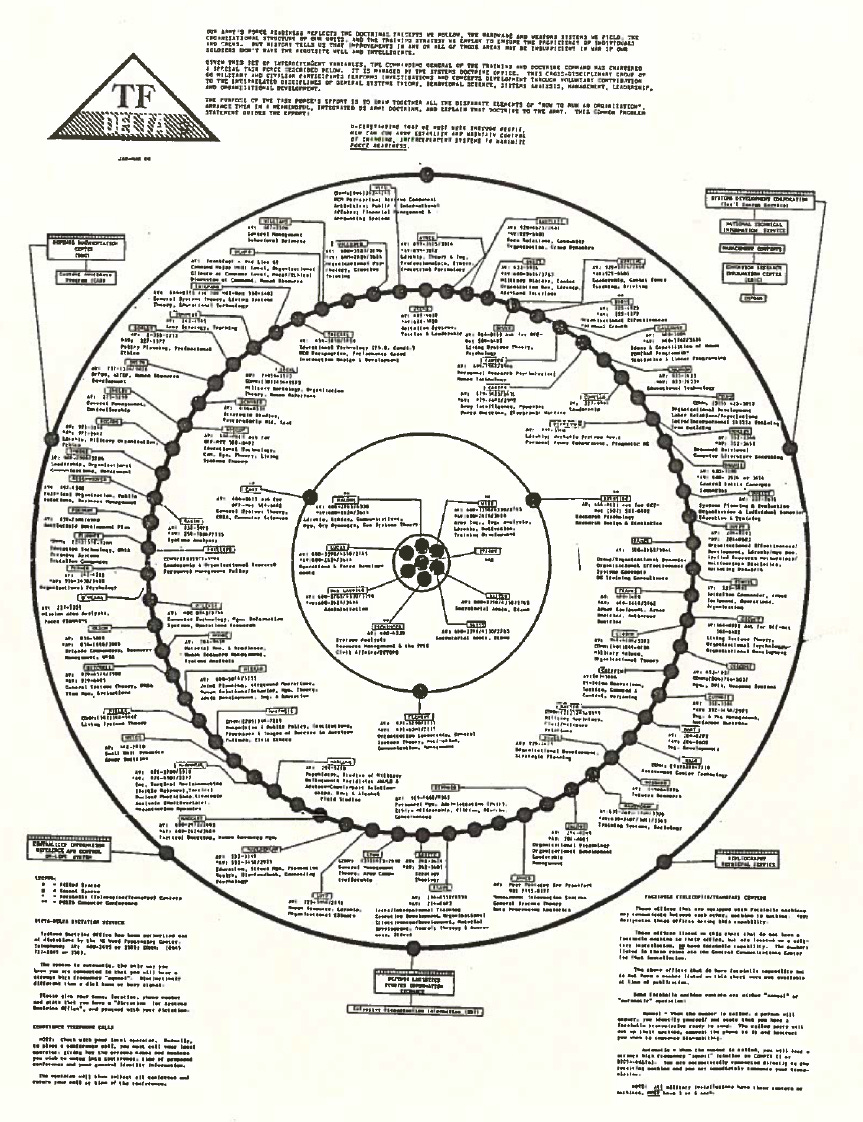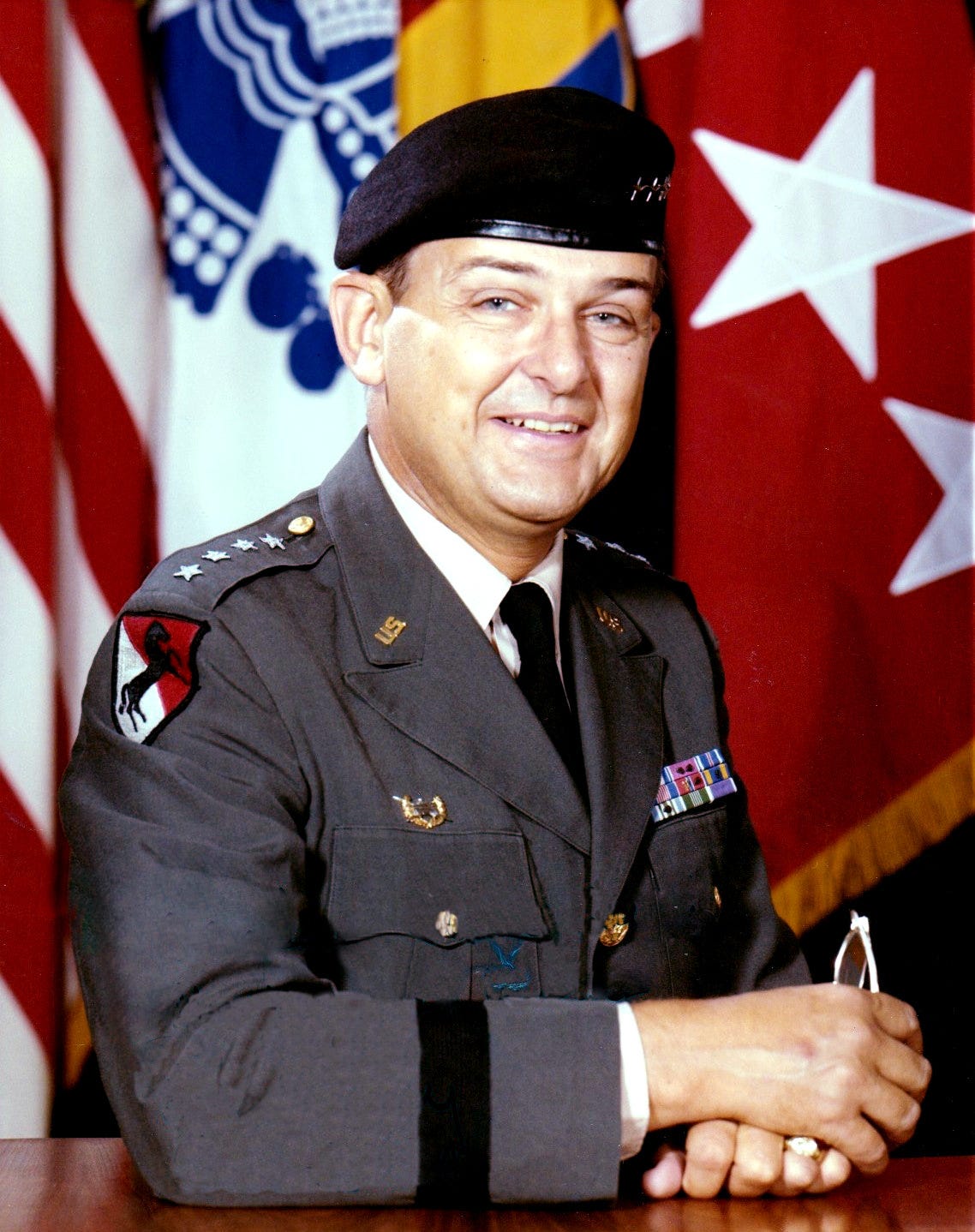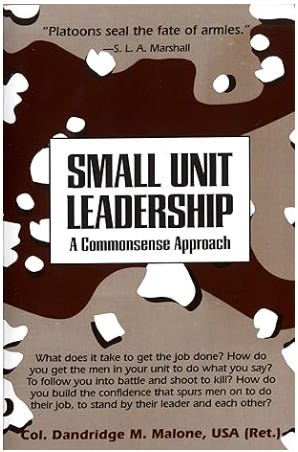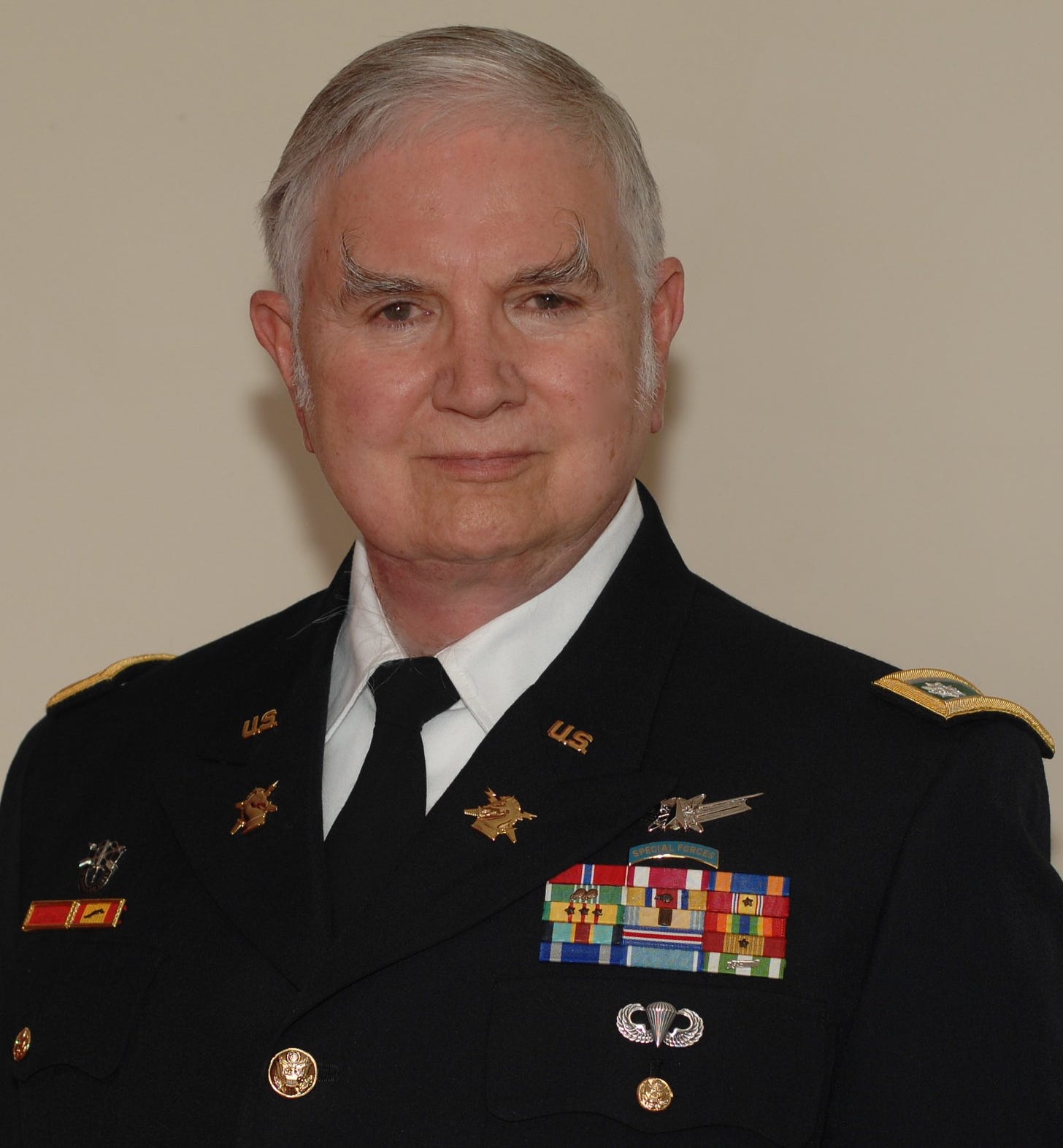Following the death of the draft (1973), the US Army needed to reinvent itself. This would take a decade, and be driven by General Donn A. Starry and his trusted friend, Colonel “Mad Mike” Malone. They would create a study group called “Task Force DELTA”. To carry out their brainstorming secretly, efficiently, and remotely, they would use the earliest form of the Internet: the “Meta Network”.
1973 taught the Army many lessons in humility.
The “Yom Kippur War” proved that a small country could beat a big one, even without jungles and guerilla warfare to blame. General Starry was there, on the ground, as part of an observation team. He watched them outthink, outfight, and outmaneuver greater forces. They had the right mixture of… something. He didn’t know what.
But he needed to find out as soon as possible. This is why, despite the Vietnam War officially “ending” in 1975, a small batch of forces would continue to occupy it for much longer. Pentagon brass wanted to recreate the conditions of the Yom Kippur War inside Vietnam, using only a few companies of highly-empowered, mixed forces.
…the message I’m trying to draw out…has to do with the effectiveness of units. For it is quite clear to me that, unless we have an Army in which most units are somewhere in the effectiveness range represented by the “well-trained crews in well-trained units” delta, we haven’t a prayer in a battle in Central Europe for sure, and probably not much of one against larger Soviet-trained and equipped armies in the Middle East.”
—General Starry, 1978 (emphasis mine)
Junior officers were promised rewards if they conducted themselves valiantly. As the experiment drew to a close, veterans would be absorbed into a special think tank back in America, called Task Force DELTA.1 The name was a reference to Starry’s call for more effective units, which wanted to find the correct “delta”—or sweet spot.
Task Force DELTA was invite-only, voluntary, and consisted of a diverse group, never more than 100 at a time, but involving around 300 over time. Officers and soldiers met with experts on diplomacy, psychology, creative problem solving, technology, and regimentation. The whole thing was authorized and overseen by TRADOC (Training and Doctrine Command), which was helmed by General Starry himself.
Save the Army, save the world
Approximately 50 members would begin Task Force DELTA. They met four times a year in Fort Leavenworth to share their theories. A legendary battlefield commander, colonel Dandridge Michael Malone (“Mad Mike”)2 was the face of the operation, making membership appealing. He had won fame for his ability to turn random conscripts into unified fighting men.
It was his job to write down the group’s conclusions in plain English for TRADOC, but this was mostly a cover story for what would really take place. He assembled the experts and collected their opinions, but he already knew how to make units more effective. He published a book on it, a few years after Task Force DELTA’s formation, and called it “commonsense”.
This basic manual would satisfy the Pentagon. But the real conversation got weird fast.
Task Force DELTA opened Pandora’s Box, and once it was open, it couldn’t be closed. With so many free-thinking experts gathered in one room, authorized to discuss the problems of the world and make radical solutions, it was inevitable that they would connect far too many dots. They constructed (mostly true) conspiracy theories and apocalyptic scenarios. They all knew about the CIA and the Syndicate’s criminal operations, which were already creating blowback around the world. At this rate, none of them believed traditional values would last into the 21st Century. Something big needed to change. In the early 1980s, everything was chaos, wonder, and futurism. They saw their true mission as leading humanity into the next millennium.
Some of their conversations included:
Psychedelics as a gateway to higher consciousness
Soviet psychic spies
Advanced weaponry like death rays
UFOs and paranormal activity (especially reported by Navy)
“Miracles” and spiritual war (as reported in Israel)
Within their own realm of military officers, they were aware of Lieutenant Colonel Michael Aquino, another soldier from Vietnam with big ideas, but one who was openly advancing Satanism on daytime TV for some reason.
They also knew about MK-Ultra, Monarch, Artichoke, and other Syndicate programs to inflict trauma-based mind control on children. Trafficking rings, incest, and ritualistic sacrifices were happening in compromised police districts as part of the ongoing “mind war” against Christian values, initiated by Allen Dulles and the CIA. FBI detective Ted Gunderson exposed this in his books:
The same black ops unit who kidnapped, raped, and murdered tens of thousands of Vietnamese civilians was being deployed in America to sow the seeds of evil. They would not be shy about targeting kids in sleepy little towns and big run down cities. Black ops units were already trained in “counterinsurgency”, which involved evading detection from authorities while building up a cult-like following out of confused or immoral locals. Why couldn’t it be done in the USA? Cheap narcotics were flooding into the country more than ever through Operation Gladio and Vice President Bush, and these created a fast track to depravity.
Blackmailing government officials was only one byproduct of this spiritual war, but it would become increasingly useful as the Syndicate took over institutions. Alfred Kinsey’s child-rape “studies” and the “Sexual Revolution” also provided cultural cover, making it easier to dismiss alarmists. Not only that, in 1980, a Syndicate-adjacent billionaire named Ted Turner created Cable News Network (CNN) to help spin any damning stories with 24 hour news coverage.
The real war
In other words, while there was a possibility that the Army might have to deploy to Europe to save them from a Soviet invasion, there was already a war at home. Beyond criminality, there was a growing materialist, socialist, globalist effort to abolish patriotism and drag the youth into apathy, hedonism, and mindlessness. Across college campuses and company boardrooms, America’s enemies were gathering strength. Yuri Bezmenov confirmed exactly this scenario in his warnings, showing that it was a deliberate plan of the Soviet Union, as they prepared to transition from a proper geopolitical bloc to a mind virus of subversion:
Besides this, there were Deep State tentacles sprouting elsewhere: NGOs, who recruited Syndicate men to steer global policies and get their puppets into positions of power. Groups like The Trilateral Commission, funded by David Rockefeller and headed by National Security Advisor Zbigniew Brzezinski, and the Club of Rome, a byproduct of Operation Gladio and the Italian connections made there. The Club of Rome had commissioned a study out of MIT (Massachusetts Institute of Technology), called The Limits To Growth in 1972, which called for depopulation and deindustrialization. By the early 1980s their ideas were being taken very seriously in universities around the world.
Task Force DELTA saw the world as a grand chess game, between these nefarious influences and their own small band of far-out heroes. They would take on an increasingly messianic role for themselves, knowing that they could never share their real conclusions with TRADOC. Instead, they would spread their ideas informally through the ranks with a sort of evangelism, without the need for oversight or budget. Doing more with less was their whole plan, after all. The only way to prove how effective their methods were would be to do the impossible with no resources at all.
Thus, General Starry’s desire to accomplish more with less reached its logical extreme: a loose-knit think tank that would engineer a New Age led by the Army. Their time scale was longer than the Syndicate’s, and their mission was too silly-sounding to be opposed. They would help discredit their own operation and muddle the waters with similar-sounding offshoots, just to throw off researchers. They would try to expose the conspiracy and build up a civilian resistance. Ultimately, they hoped to defy the very limits of humanity, transcending to a state of empowerment and unity. Whatever that might mean.
Online think tank
“Mad Mike” Malone decided that, between their quarterly meetings in Fort Leavenworth, they should stay in touch and leave the door open for more suggestions and debate. (It would be hypocritical of them not to, since two-way communication was the central demand of their entire program.) Many were computer illiterate and sent letters to their superiors within the group, but this was slow, and limited access. The real insiders used a brand-new secret technology called the “Meta Network”, which had been developed by Colonel Frank Burns. It was a prototype of the Internet we use today, with its own online community dedicated to Task Force DELTA.
Frank Burns believed this invention would change the world if it ever reached society, especially if the Army helped to steward its development. He wanted to unify mankind with a higher purpose. Through this we would begin “closing the gap between the human condition and the human potential.”3 Yes, the Human Potential Movement was baked right into the first online community, and it was Task Force DELTA who would spread it. Burns became a central player in the proliferation of this new psychic war.
And he was best friends with Colonel Jim Channon.

Also among their ranks was Dr. Steve Pieczenik, the psychological warfare expert.
It maybe impossible to discover which “circles” of the group they belonged to, but considering Channon’s close relationship with Frank Burns, and the astounding legacy he has left behind, he was probably close to the nucleus.
As for Pieczenik, he went on to serve in the State Department itself. Obviously his contributions were considered worthy of promotion. Since then he has flexed his influence in the intelligence world for decades. You may have seen him dozens of times on The Alex Jones Show.
Conclusion
We’ve all heard that the Internet was a military project created in the 1970s, but hardly anyone knows that it was, in some ways, built for this radical Army think tank. Task Force DELTA’s members were obsessed with fringe theories which, today at least, are exploding in popularity once again. This shouldn’t be surprising, as their own manifesto emphasized six areas of intellectual mastery, and each of them has to do with controlling how people think:
Process of Influencing People
Process of Control
The Dynamics of Change
The Nature of Interdependence
The Science of Systems
The Dynamics of Force Readiness
These can be applied to domestic American life just as easily as military training. It was time for the Army’s finest to join the “mind war” that the CIA’s founder had called for decades earlier.
However, there is still a question about this group’s survival and legacy. Most assume that it dissolved and became embarrassing over time. I think the opposite. I think it evolved, spread out, and outgrew the military completely.
Much of the data I found on this topic came from an essay (draft) produced by Jonathan E. Czarnecki, a professor at the Naval War College, whose document is provided at the end of this post as a PDF. Part of his conclusion deals with this exact question (I’ve made minor readability changes):
Task Force DELTA was a unique organization within an larger military service that was facing existential challenges, internally and externally. It was a high performance organization that excited its members and, for a while, excited its clients (ie. senior Army leadership.) That much can be garnered by reviewing the many concept papers and general officer comments on its work.
An old saying goes, “strange times produce strange heroes and heroines”; that seems applicable here. As long as DELTA had a well-respected leader from the combat arms (Malone) and active leadership support (Starry and Meyer), the larger organization tolerated and even embraced the strangeness. But such a combination, reliant as it is on dynamic interpersonal relationships and the inevitable tenuousness of military assignments, also means that the task force’s days were numbered from the very beginning. Indeed, many observers note that the Army’s own transformation efforts effectively were completed by 1982 (Nielsen, Romjue, Lombardo.) What would be the need of a task force searching for answers to a question that was already answered? [emphasis mine]
This is a good question. Was the point of Task Force DELTA solely to fix the command structure of the Army? Officially, yes. But if this was all they wanted, they could have gotten “Mad Mike” Malone to write the book by himself. No, there must have been a much greater reason to gather so many radical people, and to let them stray so far in their ideas. Secretly, the goal was to leapfrog Israel, the Soviets, and the Syndicate factions in what could be called the burgeoning psychic war between good and evil, where American society was just as valid a battlefield as Europe or the Middle East. General Starry was tired of watching his nation fall into the hands of demon worshipers, communists, and pedophiles. He gathered hardened veterans and dreamers alike, not your run-of-the-mill drill sergeants.
In other words, putting these particular men together must have been an effort to open Pandora’s Box in the first place. It was impossible that these men would forget such a unique and empowering experiment. Talking to smart people and brainstorming solutions is addictive. Their “dynamic interpersonal relationships” (ie. friendships), theories, and visions would endure far beyond the task force itself. This project ensured that, even when their program was officially shut down, they would continue to serve their country and use the systems available (created by them) to fight the good fight. They had all embarked on a voluntary, secret mission to apply the principles of their leadership skills to the weird world ahead.
I bet you enjoyed that one! I know I did. In the next part we will continue to dig deeper into these men, their history, and the crazy ideas that followed in their wake.
This is rare material, so please consider cross-posting this on your own Substack, or sharing a link on your social media, or even contributing with a paid subscription. God bless you.
There are plenty of groups called Task Force Delta, before and after. The one we’re concerned with is capitalized DELTA to distinguish it.
What are the odds that the Syndicate would be started by a man nicknamed “Wild Bill” and the counter-force in the Army would led by a man nicknamed “Mad Mike”?
Frank Burns wrote a poem about the Meta Network, which I found in The Men Who Stare At Goats, page 171, chapter 10, “A Think Tank”. He wanted mankind to evolve, and Task Force DELTA was the first major application. When Frank Burns died, his military grave marker included a Buddhist Wheel of Righteousness.







Interesting. So the Pentagon Collapse group can from there?
Reminds me of the funny scenario in my head about the poachers saving the gazelles from the face eating leopards…